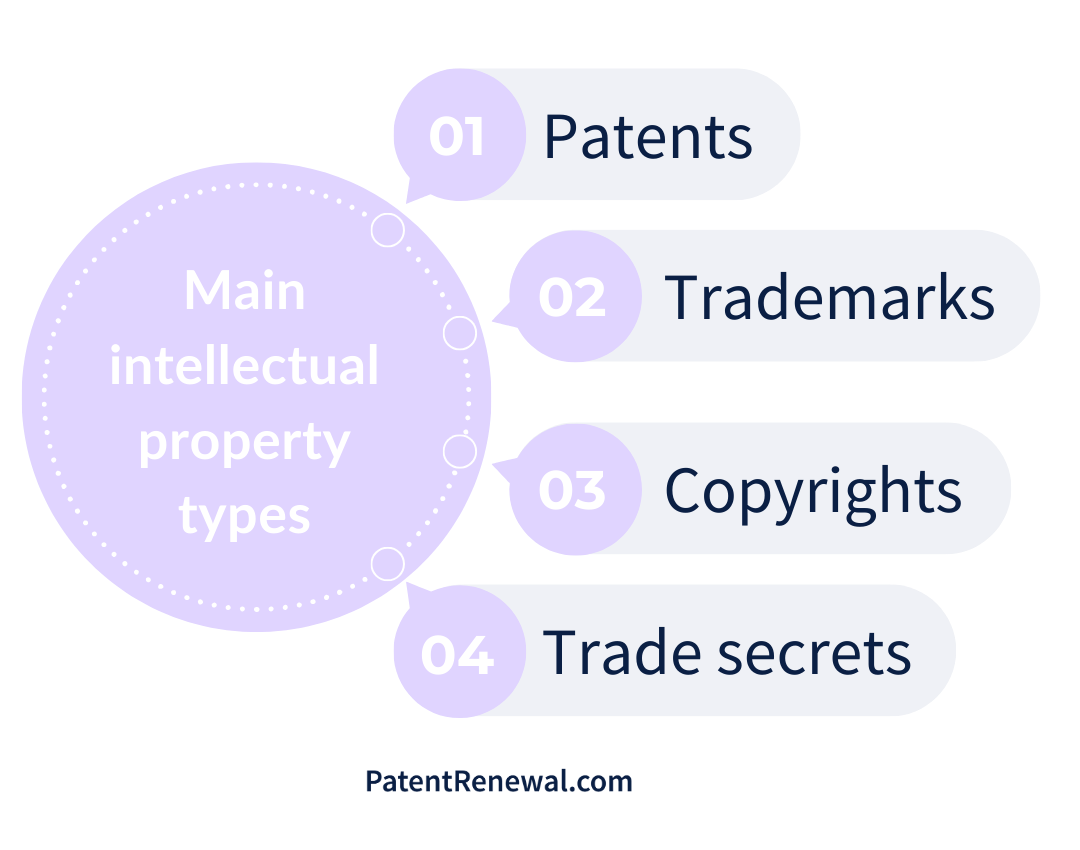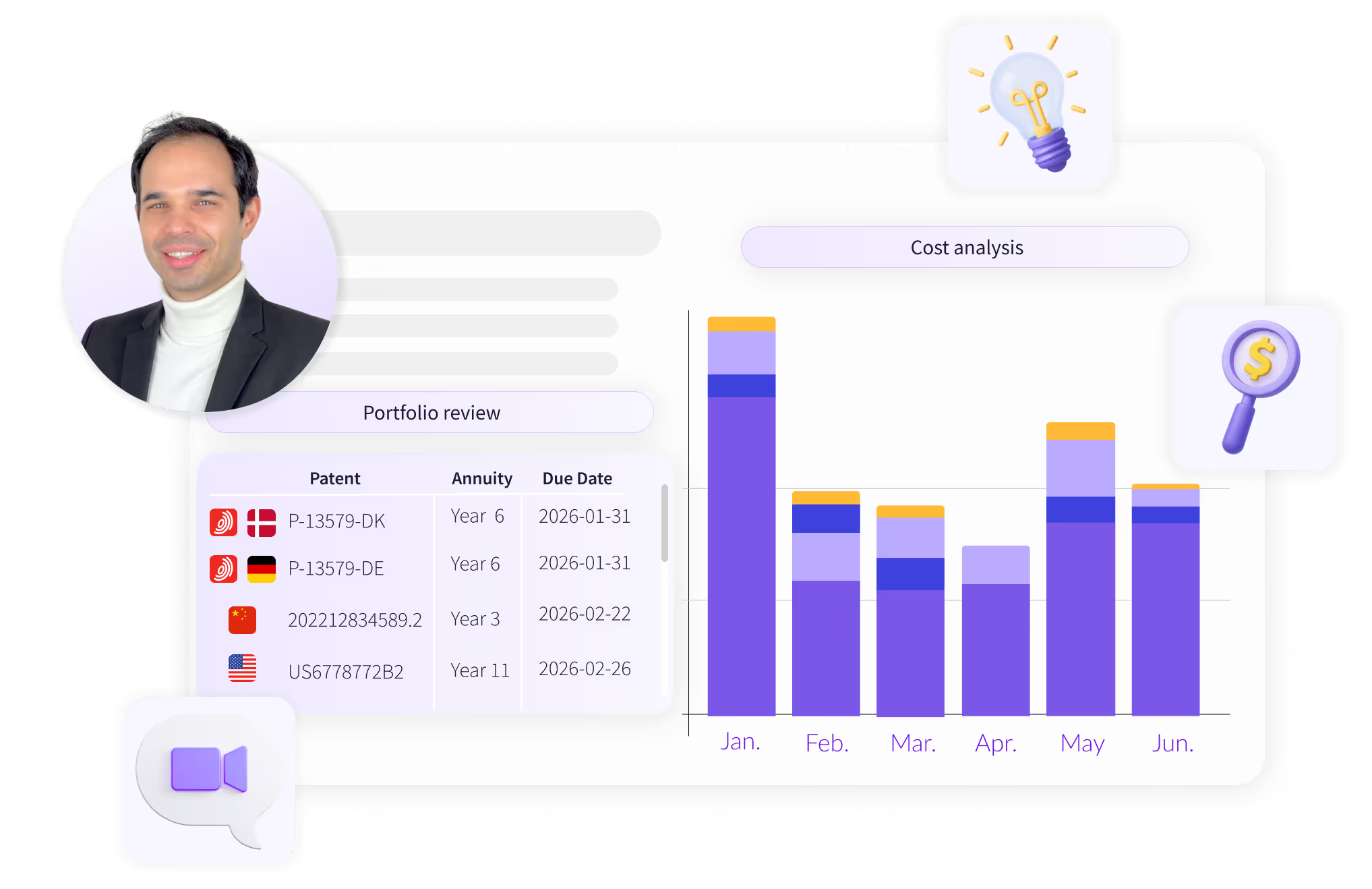TRY OUR NEW (FREE) IP RENEWAL COST CALCULATOR
Calculate.avif)
Intellectual property, shorted as IP, represents one of the most important starting points for inventors and businesses across the globe. For those whose work is influenced by innovation, having in-depth knowledge can offer both protection and profit. Let's explore the different types of IP, their significance, and how you can effortlessly manage intellectual property in today's digital age.
Intellectual property is the creation of the mind, whether it's an invention, literary work, or even a brand logo. In a world driven by innovation, the value of ideas has skyrocketed. Protecting these ideas becomes essential, which is where IP laws and rights come into play.
Individual inventors and corporations tend to invest in intellectual property to protect their innovations. Well-protected IP not only fights against potential copycats but also establishes a unique market position. Essentially, it becomes an asset – one that can be licensed, sold, or used as leverage in business negotiations.
In the world of intellectual property, we can tell apart four different groups: Patents, Copyrights, Trademarks, and Trade secrets. For better understanding let’s discuss each of them briefly.
Patents are legal protections granted for inventions, ensuring exclusive rights to the innovator for a set duration. Widely used in every industry, especially in the technology and pharmaceutical sectors. By securing a patent, inventors can confidently introduce breakthroughs to the market, knowing their efforts are safeguarded from replication.
Typically, patents are valid for 20 years from the filing date, contingent upon the payment of scheduled fees. In most countries, they need to be renewed yearly by paying a fee to the local patent office to remain in force (Some exceptions include the United States, where patents need to be renewed every 3.5 years). These patent annuity fees vary by jurisdiction and ensure continued protection, compelling IP holders to evaluate the ongoing relevance and profitability of their inventions. It's vital to ensure that they are renewed on time, keeping the IP safeguarded from potential imitations.
Our Patent Renewal Fees database on our website offers all information you need to know about how to renew your patent in different countries around the world, and provides up-to-date information about the official fees (paid to local patent offices) based on the annuity years.

After a patent reaches its expiration, your invention or product enters the public domain, allowing anyone, including competitors, to produce and sell it without facing any legal consequences.
Utility models are available only in certain countries and they provide a simpler and more cost-effective way of protecting an invention, especially in jurisdictions where the patenting process might be more stringent. While they offer shorter protection durations, they play a pivotal role in managing intellectual property, especially for domestic inventors and businesses eager to quickly safeguard their innovative ideas.
Utility model protection is limited in time and it’s country-specific. Utility models are generally protected for 5 to 10 years from the date of filing of the utility model application, but in some countries the protection is valid for up to 15 years. Utility models need to be renewed annually in some jurisdictions, in others, renewals are only mandatory every 2-5 years.
When an invention's surface structure is unique, design rights should be protected as well. A design patent offers legal safeguarding for the original visual/aesthetic aspect of a produced product. This type of patent is issued when a product has a unique shape, specific decorative features on its surface, or a combination of both.
A design generally has a lifespan anywhere from 10-25 years, and depending on the country renewal payments are necessary at different intervals. In most European countries, designs need to be renewed every 5 years and the renewal fees must be paid within the last 6 months of the validity period. In other regions, design renewals vary from being required yearly to no maintenance needed at all for the entire validity period.
If you have patents, utility models or designs, PatentRenewal.com offers an innovative way of renewing them via our intuitive IP management software. Find out more about our solution.
The guard of the artistic intellectual properties is copyright. From books, paintings, movies, photographs, illustrations to music, copyrights protect original works of authorship.
When you produce work of a literary, scientific, or artistic nature, you're automatically granted copyright protection from the instant your work is created, eliminating the need for a formal application process. Nonetheless, it might be necessary to inform others of your authorship of the work. You can do this by affixing a copyright notice to your work, like the "all rights reserved" phrase, or the © symbol, along with the year of creation. You also have the option to register your copyright, as this step can be beneficial in authenticating the existence of your work. It's crucial for creators to know their rights and how to enforce them, as these masterpieces are easy to copy and without the required knowledge creators can lose their credits easily if they don’t register their content on time.
They are different from patents because they don’t need to be renewed, copyrights are protected for the creators’ life and at least an additional 50 years (in the EU and United States, it is 70 years after death).
Trademarks are responsible for protecting the brands’ identities. They are often represented by logos, brand names, slogans or words, they are known as a company's identity in the marketplace.
Trademarks that are distinct and visually attractive often rank as some of the most precious elements in a company's intellectual property collection, playing a crucial role in establishing and maintaining a brand's reputation. Trademarks also serve as a form for the emotional responses consumers have towards a company, influencing how they view and interact with the business.
Trademarks are similar to patents in a way they need to be registered to be protected and they have to go through a renewal process typically every 10 years if the owners want to keep them alive and protected.
Trade secrets are the silent assets of businesses. Trade secrets are usually formulas, practices, or any information that provides a business edge. As there is no renewal process to keep them officially protected on the market, companies often ask employees to sign an NDA to ensure the safety of this information. Unlike other IP types, trade secrets are protected as long as they remain secret, therefore the IP holders don’t need to renew them as long as they can keep this information internally.

Beyond the commonly known IP rights, there are others, like geographical indications, database rights, and plant varieties. Each one of them offer unique protection, emphasizing the vastness of the IP domain, but to get the full picture, let’s introduce them one by one.
They refer to a sign used on products with a specific geographical origin, possessing qualities, reputation, or characteristics essentially related to that specific location. For instance, champagne from France or Darjeeling tea from India is strongly connected with the location of the distribution. Geographical Indications ensure consumers get genuine products while helping producers establish a premium identity.
In numerous unique legal frameworks, geographical indications don't have a predefined expiration date once registered. Their protection continues indefinitely, unless there's a cancellation of the registration. On the other hand, when geographical indications are registered through collective or certification marks, they typically enjoy protection in ten-year intervals, with the possibility for renewal after each term.
They protect the effort, time, and money invested in collating data, even if the data itself isn't original. It's particularly relevant in our digital age where huge amounts of data are compiled for various uses.
In those countries that recognize database rights, their protection is valid for 15 years from their creation, therefore their owners don’t need to renew them until they expire. However, with each significant modification of a database, a fresh set of rights for that particular database is established.
Plant varieties represent a unique type of intellectual property, focused on protecting new, distinct, and stable plant breeds. These rights encourage botanical innovation, ensuring breeders have exclusive control over their creations. Just as patents guard inventions, plant variety rights ensure the efforts behind agricultural advancements remain recognized and rewarded.
The majority of plants have a 25-year long lifespan if they are renewed regularly. In case trees, vines, flower bulbs etc. are protected by these plant varieties, the lifespan is 30 years from the date of the grant of protection.
IP violations can range from patent infringements to copyright piracy. For instance, selling a patented technology without authorization or copying a book's content without permission can lead to severe penalties. Being informed and proactive is the best defense against such infringements.
Franchises, on the other hand, don't strictly fall under the traditional IP umbrella but are closely connected. They work more like a system that provides the use of other companies’ trademarks legally. In this case, the companies, the franchisors, are in contract with the franchisee, therefore they are allowed and required to use the trademarks, and business models of the franchisors within specific locations. The best examples are fast-food chains that have spread globally but operate under consistent standards.
At PatentRenewal.com, we understand the complexity of IP rights. We offer a software platform that simplifies and digitalizes the renewal process for patents, designs, and utility models.
We manage intellectual property for a friction of the usual market price, backed by a team of IP experts and a supportive customer support team, ensuring your IP portfolio remains safe and intact. You don’t need to handle multiple reminders and get lost in deadlines.
Remember, managing and renewing intellectual property doesn't have to be complicated – especially with experts by your side. Request a price comparison and book a demo with us!
Interested in a free IP renewal consultation? Benchmark your current IP renewal setup and costs against market standards.
